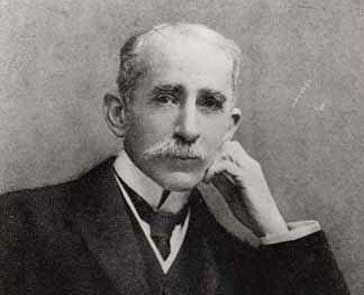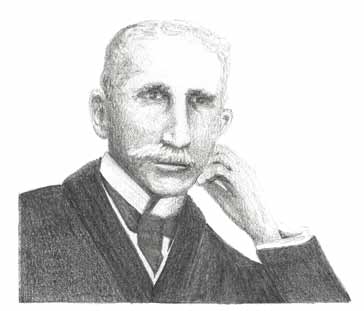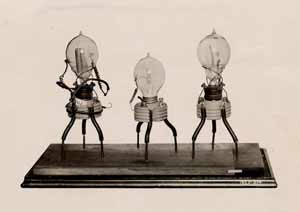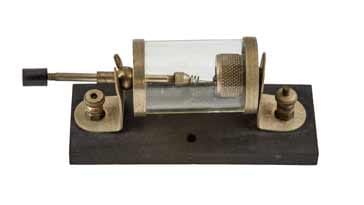John Ambrose Fleming - short biography
Biography of Professor Sir John Ambrose Fleming, inventor of the oscillation diode valve or vacuum tube who some say is the founder of electronics
John Ambrose Fleming Biography Includes:
Sir John Ambrose Fleming
Books & publications
Facts & quotes
Professor Sir John Ambrose Fleming is one of the great men of radio and electronics.
Fleming is for many inventions including his right hand generator rule and left hand motor rule, and he also undertook a lot of research into electrical measurements and machinery.

Fleming also was also a pioneer of early radio, designing the transmitter for Marconi that was used for the first transAtlantic transmission.
However, possibly Fleming's greatest invention is that of the thermionic valve or vacuum tube. This enabled wireless and later electronics technology to move forward, enabling the first wireless sets with a reasonable performance to be manufactured. As a result of this contribution, some refer to Ambrose Fleming as the Father of Electronics.
During Fleming's retirement he took a keen interest in a vast number of other topics associated with electronics which included the new area of television.
Fleming's early years and education
John Ambrose Fleming was born on 29th November 1849. He was the eldest of seven children born to a Congregational minister. Although born in Lancaster his family moved to North London where he spent most of his early life. He was educated mainly at University College School on Gower Street in the West End of London.
On leaving school Ambrose Fleming entered University College London where he studied for his bachelor's degree under two famous names: de Morgan the mathematician; and Carey Foster the physicist.
Unfortunately Fleming had to leave after the end of his second year. His studies stretched the family's limited resources and he had to earn some money to continue.
This he did by taking a job with a ship builder in Dublin. He soon tired of this job and took employment at a stock jobbing firm in the London Stock Exchange where he spent two years.
The job at the stock exchange was very convenient. Work finished at 4 pm and this enabled Fleming to study in the evening and as a result, he graduated in 1870 with a first class degree, one of only two that year.
Not content with this he determined to further his studies, but before he could achieve this he needed to replenish his funds. With this aim he took up a post at Rossall School for 18 months before entering the Royal College of Science to study Chemistry in Kensington in 1872.
While Ambrose Fleming was here he first studied the electric battery and this resulted in the first paper he presented. It was actually the first one read at the newly formed Physical Society of London which later became the Institute of Physics. As such it appears on the first page of their proceedings.
Fleming at Cambridge
The lack of funds again forced Fleming to seek employment, and he became a science master at Cheltenham College.
When he was here he was able to continue his research even corresponding with James Clerk Maxwell at Cambridge University. It was as a result of this that Fleming decided to study at Cambridge under Maxwell.
Whilst at Cheltenham, Fleming managed to accrue sufficient funds to return to University so that in September of 1877 at the age of 28 Fleming entered Cambridge.
At Cambridge he studied under Maxwell for part of the time, commenting that he found his lectures difficult to follow. He graduated from Cambridge with a first class degree in Physics and Chemistry.
A year later he gained his D.Sc. from London University and then spent a year as a demonstrator at Cambridge, although by this time Maxwell had died.

Fleming enjoyed the academic life and he managed to secure the post of Professor of Physics and Mathematics at University College Nottingham, but despite this job he still wanted to return to London.
His time at Nottingham was relatively short, as he took up a position as a consultant to the Edison Telephone Company. This enabled him to see many of Edison's inventions, and he even travelled to the Edison's laboratories in the USA.
This visit was to be a crucial event although Fleming did not know it at the time but it was to shape his future.
The invention he saw was known as the Edison effect. It was found that an evacuated light bulb with a second electrode would allow current to flow from one electrode to the other, but only in one direction. While Fleming did not use the idea immediately, he took a keen note of it.
Fleming becomes professor at UCL
Fleming's long term aim was to be able to return to London. At the time there were no positions in the new and developing science of electrical engineering. Instead the nearest subject was physics.
However Fleming was invited to give a series of lectures on electrical engineering at University College London, UCL, the premier college of London University.
Then in 1885 he was asked to set up a new department for electrical engineering for which he would be professor.
This was the beginning of a long association as he held the chair at UCL for 41 years. It was also a notable first because it was the first department of its sort in the country.
Professor Fleming enjoyed both research and lecturing. As a lecturer, his students said that his lectures were well thought out and clearly presented. He even devised methods to remember things - examples are the left and right hand rules for the relationship between magnetic field, current and force in electrical machines. Even today, these are called Fleming's left hand motor rule.
Fleming spent many hours ensuring that the demonstrations were clear and that they worked well. He would arrive very punctually to present the lecture and he would expect everything to be in place with "lantern slides" set out ready for projection and nothing was allowed to go wrong.
He spoke with great enthusiasm but so fast the undergraduates were unable to take notes easily. It is said that after a lecture, many students would come out exhausted only to have to spend many hours writing up and decoding their notes that were taken in great haste.
Whilst he was an excellent lecturer he also undertook a significant amount of research. During his first ten years at University College London, UCL, most of his researches were focused towards refining the theory behind transformers.
The low voltage testing was undertaken at UCL, whilst the majority of the testing was carried out at a sub-station owned and operated by the London Electric Supply Corporation. The results were presented to the Institution of Electrical Engineers in London in November 1892 and represented a major landmark in the understanding of transformer theory.
Accordingly Fleming became a leading authority on transformers as well as performing much valuable work on improving the accuracy of AC measurements.
Fleming's oscillation valve foundations
Fleming's discovery of what he termed his oscillation valve, was major milestone in the development of what we know today as electronics.
Thermionic of vacuum tube technology was to change the direction of electrical science and spawn the new field of electronics.All of this came out of investigations into wireless or radio communications technology.
Foundations for Fleming's valve discovery
In 1899 Fleming became a consultant to the Marconi Company in addition to his duties at University College London.
This was a post that he held until shortly before his death. At this time, wireless, as it was then known, was still in its infancy and Marconi was continually making an improvement in the distance that could be achieved using his radio communications systems.
In 1901 he succeeded in sending a message across the Atlantic. Fleming had designed the transmitter for this great achievement and had become very absorbed in the subject.
Fleming was noted as being somewhat eccentric. During his experiments with transmitters he would always use the letter V sent in Morse ( . . . - ) as the test letter and he became so involved in this work that he would often be heard unconsciously humming the letter V or whistling it between his teeth.
Fleming had previously become involved with wireless through Maxwell who had devised his electromagnetic theory that proved the existence of these waves.
Now Fleming was involved in moving this further forward. As such he was aware of the limitations preventing further progress.
He was acutely aware of the insensitivity of the detectors. The coherer that was the most common way of detecting signals was not particularly sensitive, although it had been refined to a remarkable degree.
Edison effect recalled
It was now that Fleming recalled the Edison Effect he had seen many years earlier in the USA. Although he had experimented with it in 1883 and later in 1896 and had special lamps made he could find no use for it.
Others had also seen that the effect and noted that it could be used to rectify alternating currents, but it was Fleming in a stroke of genius who realised that it could be used for detecting radio signals.
Fleming had what he described as a "sudden very happy thought" one day when he realised the possibilities. So in October 1904 he asked his assistant, G.B. Dyke to put the idea to the test, and it worked. Thus it was that on 16th November 1904, Fleming was seen "scudding down Gower Street" in London, oblivious to all around him on his way to patent the idea.
The new invention that Fleming called his oscillation valve because of its one way action was a dramatic improvement over anything that was available at the time. It enabled weaker signals to be detected, and for the first time it allowed high frequency measurements to be made.

Fleming's Oscillation Valves
Marconi plc - with permission
Shortly after his discovery Fleming wrote to Marconi to tell him of his discovery. In the letter he mentioned that he had not mentioned the idea to anyone as he thought it might be very useful. Little did he know of its importance, although he entrusted the patent to the Marconi company. However it did not bring any money to them. Any returns from the invention made were used in fighting the legal battles that were to arise later.
Fleming called his new invention an oscillation valve, and it later became known as the Fleming valve.
It took some months before the complete specification was lodged and this took place on the 15th. August 1905. Ultimately patent number 24850 was granted on the 21 September, 1905.
Fleming also patented his idea in the USA on 19 April 1905 and was granted patent number 803684 on 7th November of that year.
Competition for Fleming's valve
The invention of the diode valve or vacuum tube was a revolutionary idea, and put down the foundations for many further inventions.
However it had very little impact at first. "Valves" were expensive to make and on top of this other ideas were overtaking him. In less than two years the cat's whisker was produced.
The Cat's Whisker was a very crude form of semiconductor rectifier that consisted of a thin wire positioned on a lump of suitable material (even coal) to produce a point contact rectifier. This was far more convenient than Fleming's diode and it soon caught on.

In the USA, Lee de Forest was also interested in thermionic technology, and undertook a number of investigations into Flemings valve. He developed the idea further, introducing a third electrode he named a grid between the heated cathode and the anode. He only used the device as a leaky grid detector, it use as an amplifier would take a few years more.
de Forest took out a number of patents for his developments between 1905 and 1907. The first development was a diode that used a double battery and he called the device an "Audion". Fleming felt that his invention had been plagiarised and a bitter row broke out.
The scientific community sided with Fleming, although when tested in the law courts de Forest's patent stood.
A year later de Forest introduced a three electrode device for use as a detector. It would take a few more years before it was used for amplification. De Forest called this device an Audion as well, giving rise to much confusion. It is worth mentioning that at no time did Fleming claim to have invented the triode.
Ambrose Fleming in retirement
Fleming continued at University College London, UCL and only resigned his chair in 1926 at the age of 77 after 42 years in the post. He retired to the quiet seaside town of Sidmouth in Devon UK and today there is a plaque outside the house in which he lived.
Despite being retired, Fleming still took an active interest in many new developments in the electronics world. For fifteen years he was president of the Television Society, often travelling to London for their meetings.
Two years after his retirement John Ambrose Fleming was knighted for the many advances he had made to electrical and electronic engineering. This was only one of many honours he was given.
Although he married twice he never had any children. His first wife, Clara Ripley who he married in 1877 sadly died in 1917 and it was not until 1933 that he remarried, this time to Miss Olive Franks.
He had many "interests" outside his work. He had a keen interest in photography and loved walking. He was also a devout Christian, and this became more obvious in later life. He often preached at various churches, and in particular in Sidmouth, although once he asked to preach at St Martin's in the Fields just by Trafalgar Square in London.
Fleming remained active until his death in 1945 at the great age of 95, although he became increasingly deaf. During his life he made achieved a tremendous amount. As he had no children, he bequeathed much of his estate to Christian charities in line with his beliefs.
He was noted for his phenomenal capacity for work. Apart from his researches and lectures he wrote over 100 books and many papers for learned magazines. However he will be chiefly remembered for the invention of the thermionic diode valve that changed wireless technology for ever and gave birth to the science of electronics that is at the heart of so much that is essential today.
More Famous Scientists in Electronics and Radio:
Volta
Ampere
Armstrong
Appleton
Babbage
Bardeen
Brattain
Edison
Faraday
R A Fessenden
Fleming
Heaviside
Hertz
Ohm
Oersted
Gauss
Hedy Lamarr
Lodge
Marconi
Maxwell
Morse
H J Round
Shockley
Tesla
Return to History menu . . .



